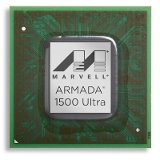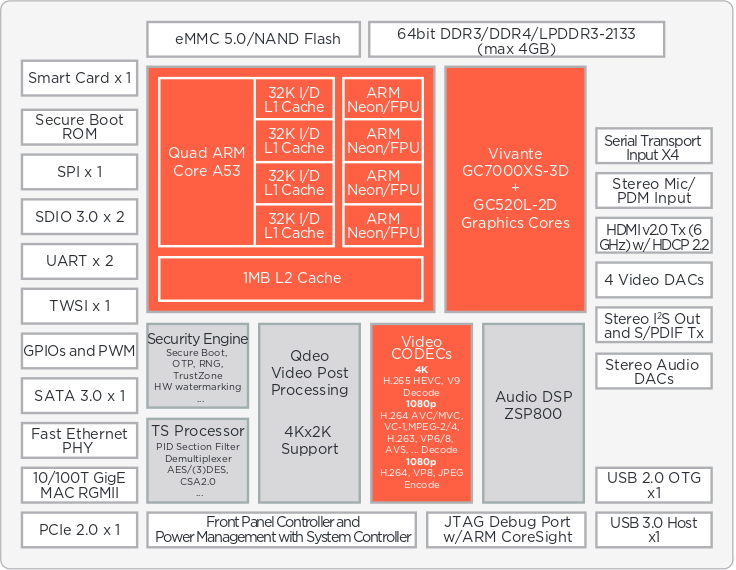 Marvell has just unveiled another STB SoC with ARMADA 1500 Ultra (88DE3218) with four ARM Cortex A53 cores, and instead of using Mali or PowerVR GPUs like many competitors, they integrated an octa core Vivante GC7000XS 3D GPU anda Vivante GL520 2D GPU into the chip.
Marvell has just unveiled another STB SoC with ARMADA 1500 Ultra (88DE3218) with four ARM Cortex A53 cores, and instead of using Mali or PowerVR GPUs like many competitors, they integrated an octa core Vivante GC7000XS 3D GPU anda Vivante GL520 2D GPU into the chip.
The SoC is designed for 4K Android set-top boxes from PayTV operators and STB manufacturers, supports 4K UHD 10-bit HEVC and VP9 video codecs, and embeds a security processor supporting conditional access systems (CAS) solutions from Verimatrix, Widevine, PlayReady, and DTCP-IP.

Key features listed for ARMADA 1500 Ultra:
- 2160p60 10 bit HEVC & VP9 Video Decode + 1080 PiP + Trancoding concurrently
- Quad Core ARM A53 64-bit CPU @ up to 1.5 GHz (Up to 14K DMIPs) with 1MB L2 Cache
- 8 core GPU, 8 shader Vivante GC7000XS supporting OpenGL ES 1.1/2.0/3.0/3/.1, OpenCL 1.2 and DirectFB. Includes HW tessellation and geometry shaders, optimized for Android L (AEP) gaming applications.
- Security Engine including Trustzone integration and support for 4K Video Watermarking.
- Quad TS inputs for DVB-S/T/C tuners
- Peripherals – SATA, USB 3.0, Gigabit Ethernet, PCIe for Wi-Fi or cable modem, Smartcard interface, etc…
The SoC will support Android TV and RDK SDK, and the company can provide references design including Marvell Wi-Fi (2×2 or 4x411ac), LTE, ZigBee and/or Powerline (G.hn) technologies.
The company did not say when the SoC or solutions will come to market, but it will demonstrate ARMADA 1500 Ultra at TV Connect 2015, London on April 28–30, 2015. You can visit Marvell ARMADA 1500 Ultra product page for a few more details.
Via AndroidPC.es

Jean-Luc started CNX Software in 2010 as a part-time endeavor, before quitting his job as a software engineering manager, and starting to write daily news, and reviews full time later in 2011.
Support CNX Software! Donate via cryptocurrencies, become a Patron on Patreon, or purchase goods on Amazon or Aliexpress





This is a High end SoC for media players, AFAIK it’s the only ARM SoC to integrate a post processing engine and 10 bit 60fps 4k hevc decoding
So this SOC has about half the DMIPS performance of Nvidias 32 Bit Tegra K1 from last year ?
It seems like that. Btw. I have Samsung Tab 4 7″ with their SoC and performance is really bad 🙁
@Peter Bauer
Doesn’t matter for this kind of SoC, the quad Cortex A-53 is enough for commun software tasks, the video audio engine and the post processing with the Qdeo are the post important here, I have a feeling that this SoC will be shown with the new Oppo 4K blue Ray player
So vivante are finally delivery some half decent video cores ? instead of graphics decelerators
Finally a SOC with full featured for a gaming, set top box A/V,media player blue ray and vivante GPU
Pretty interesting, high end SOC that look low cost
@rafael Duarte
@Al
Vivante GC7000 GPU supports 8 to 256 cores, and the one in Marvell ARMADA 1500 Ultra one has 8 cores, so don’t expect amazing 3D performance.
http://www.cnx-software.com/2014/04/19/vivante-gc7000/
It’s probably been selected for 3D user interfaces in STBs, but not for outstanding gaming performance.
Wondering if they will use Android’s MediaCodec API for Kodi/XBMC support?
Could we see a 4k Chromecast? this SoC has the power to do some nice video 4k@60fps VP9 would be great! the current Chromecast is based on the Marvell 88DE3005-A1 will see Google IO at the end of May
“Qdeo post processing engine” very Nice if it is support on sdk.
I realize this is an old comment, but I wanted to mention that I believe this is the chip used in the ChromeCast2 Ultra (Which supports HEVC, VP9, in 4K@60fps with HDR).
I’d be nice to have some more specs, like CPU mhz, etc… The Chromecast-2 used a dual core arm 1.2Ghz processor although all video decoding is done by hardware decoding, hence why xvid isn’t supported (although other h.263 methods [divx] files will work) [compatibility is undocumented on the google dev/sdk site] I can confirm on the CC2 [& presumably CC2Ultra] as long as it’s in a supported file format (mp4/mkv mainly, though some applications can convert/emulate the filetype and insert/load the media stream within it on the fly).
I don’t know how much control the sdk gives over CPU operations as it was designed specifically for minimal cpu use handling html5 based display with googles sdk backend control/config operations and designed video to be hardware decoded only.